In June 2023, China boasted a staggering internet user base exceeding 1.07 billion, showcasing a robust internet penetration rate of 76.4%, surpassing the global average of 65.7%. This pervasive internet presence has seamlessly woven into the fabric of Chinese society, influencing every facet of daily life. Leveraging this transformative trend, businesses are strategically amplifying their investments in online marketing to not only expand their consumer reach but also solidify their brand standing.
Download our report on Gen Z consumers

Among the strategies employed in this digital landscape, Baidu Search Engine Marketing (SEM) takes center stage alongside Baidu SEO. Recognized as integral components, these tools serve as key conduits for businesses seeking to connect with the vast and dynamic online audience in China.
Baidu is China’s leading search engine
Baidu was founded in January 2000 in Zhongguancun, Beijing. As the largest Chinese search engine, Baidu responds to billions of search queries from more than 100 countries and regions every day. As of June 30, 2023, Baidu APP Monthly Active Users reached 677 million, a year-on-year growth of 8%. In 2023, Baidu held 55.8% market share of the Chinese search market.
However, foreign companies entering China cannot use the same Search Engine Optimization (SEO) methods on Baidu as Google. This is mainly because Baidu has its unique characteristics and challenges, such as complex language issues, cultural differences, user behavior, legal considerations, censorship and technical considerations.
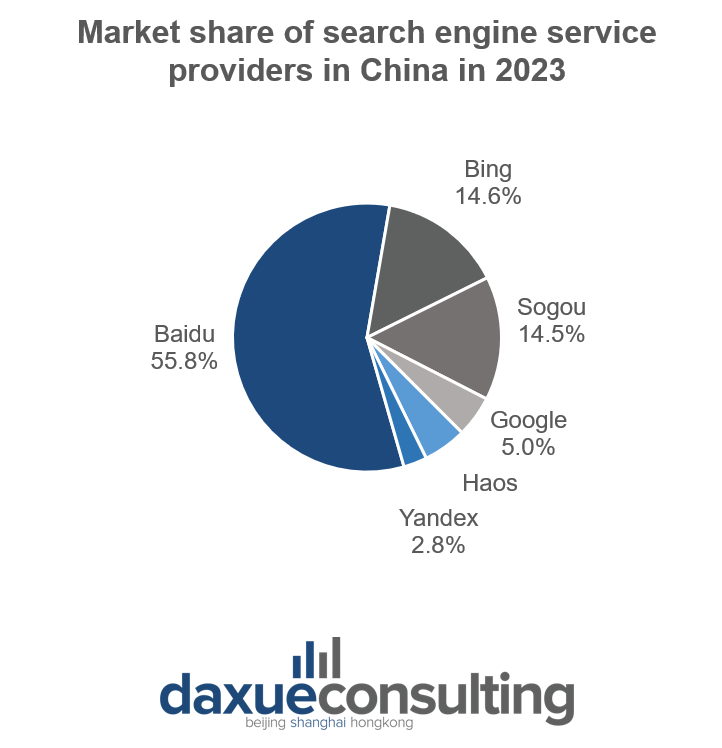
While both Baidu and Google are prominent search engines, it’s crucial to note the distinctive marketing tactics each platform employs. For instance, Baidu’s approach, particularly with paid search ads, differs from what companies might anticipate on Google. While Google prioritizes certain metrics and strategies, Baidu operates within its own ecosystem, often requiring tailored approaches to effectively navigate its advertising platform. The first thing to get familiar with regarding Baidu SEM is Baidu Marketing Centre.
What is the Baidu Marketing Centre?
Baidu Marketing Centre (百度营销中心) is Baidu’s commercial product and service platform. This centre brings market trends, commercial product dynamics, marketing solutions and other information to merchants through diversified content formats such as special topics, live broadcasts, audio and video, to help better marketing decisions and commercial promotion.
As seen in the visual above, this centre consists of three main parts, which are ad design, monitoring, and ad placement. Advertising services are available in different forms: such as search ads, display ads, mobile ads, and forum ads.
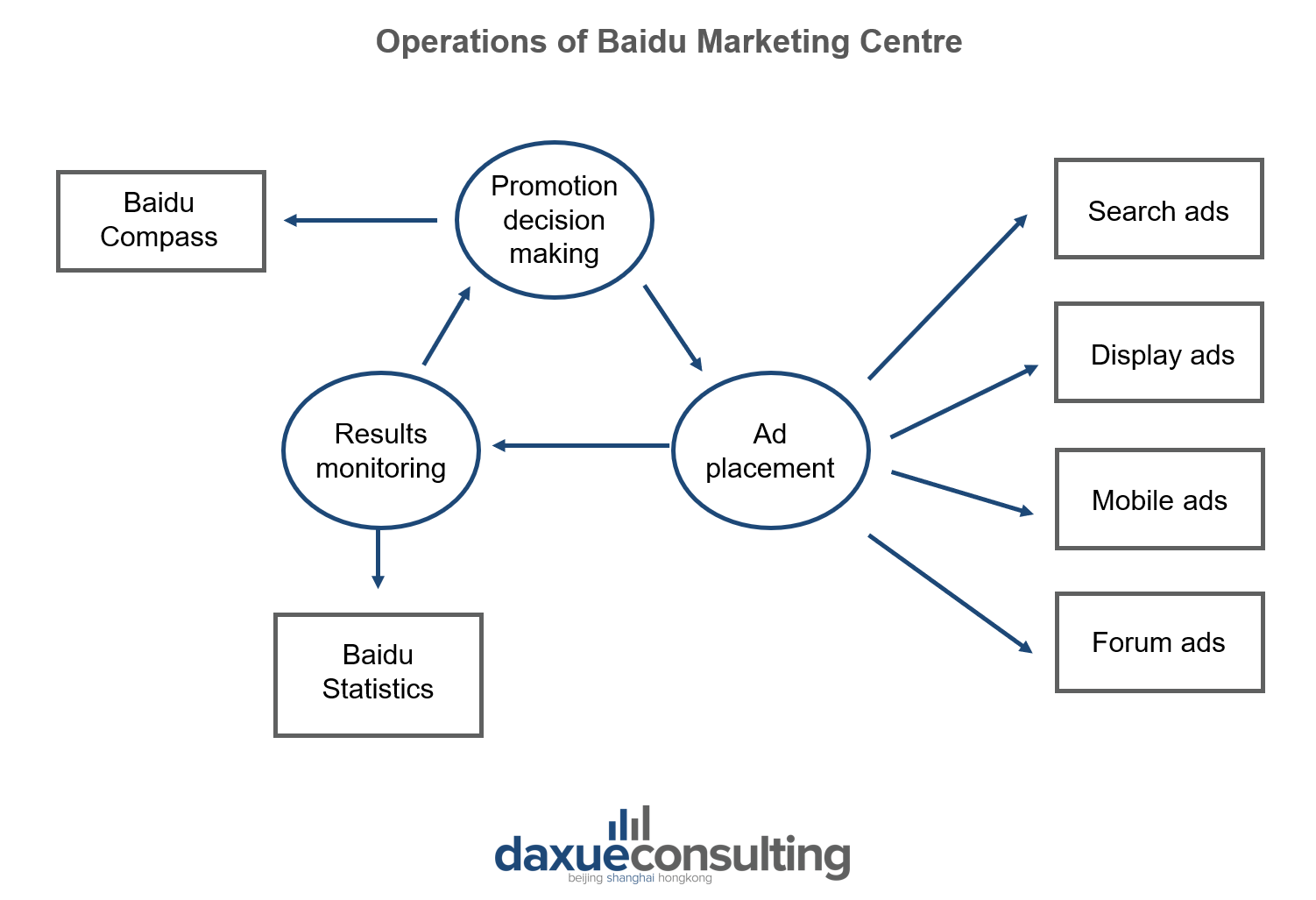
Baidu offers diverse advertising formats catering to different platforms and user preferences
Search ads
Baidu provides a range of advertising formats to meet specific objectives and target audiences. One prevalent form is search ads, displayed on search results pages through keyword advertising. Positioned alongside organic search results, these ads effectively capture users’ attention during their search queries, driving targeted traffic to advertisers’ websites.
Search ads operate on keyword targeting, where brands bid on relevant keywords to ensure their website appears prominently when users search for those terms. The mechanism relies on a bidding promotion system, determining the ranking of search results based on advertisers’ bids. As users input keywords, Baidu organizes search results, with higher investments leading to higher rankings. This makes Baidu Search Ads a strategic choice for brands seeking prominent online visibility.
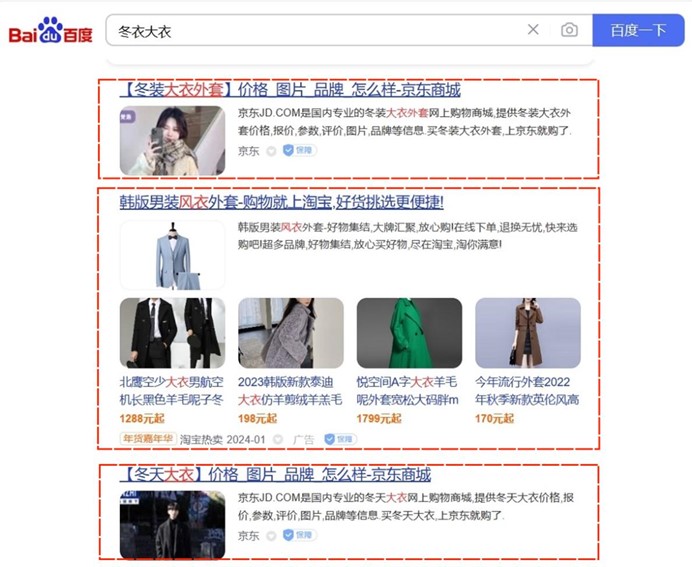
Display ads
Baidu Display Network ads extend across Baidu’s ecosystem, including search, forums, and Q&A platforms, allowing advertisers to choose from text, image, and video formats. This variety enables advertisers to create visually compelling ads that resonate with their target audience. Additionally, advertisers can leverage precise targeting options based on factors like geography, demographics, and interests, ensuring that their ads reach the most relevant users.

Mobile ads
Moreover, mobile ads on Baidu focus on engaging users across mobile applications, websites, and Baidu’s Search app. This format offers varied options such as banner ads, search ads, and in-app ads, allowing advertisers to tailor their ad campaigns to suit the preferences and behaviors of mobile users. With the increasing use of smartphones and mobile devices, mobile ads on Baidu provide advertisers with a powerful way to reach their target audience on the go.

Forum ads
Utilizing Baidu’s forum promotion involves strategically placing ads on relevant forums by leveraging selected keywords and topics for increased visibility through paid channels. Advertisers can specifically target forums related to their industry, engaging with users actively seeking information or participating in relevant discussions. This focused strategy ensures that advertisers reach an audience genuinely interested in their products or services, leading to increased engagement and higher conversion rates.
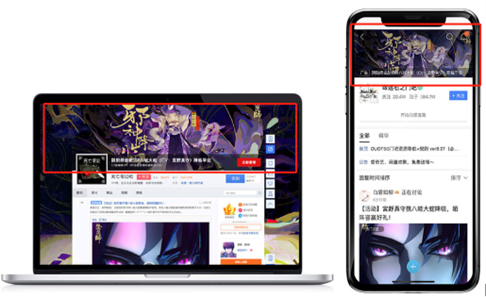
How to advertise on Baidu
Step 1: Creating a Baidu advertising account
The first step for advertising on Biadu involves setting up an account on the Baidu Ads website. The registration steps should be navigated through, ensuring accurate and complete provision of necessary information. It is important to follow the registration process meticulously to ensure all required details are correctly entered.
Step 2: Keyword research and campaign setup
Once the account is ready, it is time to outline the keyword targeting strategy. Baidu’s Keyword Planner is a powerful tool for uncovering widely-used and impactful keywords. The subsequent step involves configuring the advertising campaign, where parameters such as budget, target audience, and preferred ad formats are specified. The campaign is then customized to harmonize with overarching marketing objectives.
Step 3: Campaign monitoring and optimization
Baidu’s analytics tools, particularly Baidu Analytics, play a crucial role in monitoring the performance of advertising campaigns. This resource offers insights into visitor behavior, tracking how individuals discover and navigate the brand’s website. The utilization of such tools facilitates enhancements in visitor experience, contributing to the conversion of visitors into loyal customers. Additionally, Baidu Index (similar to Google Trends) is employed to evaluate the popularity and trends associated with specific keywords or topics. Ad performance is consistently monitored using these tools, and adjustments to the strategy are made as necessary to achieve optimal outcomes.
Potential challenges: the rising trend of young users preferring Xiaohongshu over Baidu
One potential challenge in the digital landscape is the increasing trend among young people to consider Xiaohongshu (Little Red Book) as a preferred alternative information source to Baidu. Unlike Baidu, Xiaohongshu is not a traditional search engine, but an Instagram-like social media platform, focusing on lifestyle, beauty, travel, and food.
In contrast to Instagram, users can search for content and products by entering keywords or tags, focusing on niche interests such as fashion, beauty, travel, and food. The platform provides more relevant and specialized User-Generated content compared to generic search engines. For instance, makeup enthusiasts might turn to it for detailed cosmetic tutorials, while travelers can find unconventional tips and travel guides. This preference arises from the desire for trendy, personalized, and lifestyle-oriented content, rather than authoritative or official information.
In fact, lifestyle searches occur more frequently than news-related searches, which are event-driven and less frequent. Moreover, even for news, Chinese netizens nowadays tend to seek updates on platforms like Douyin and Xiaohongshu.
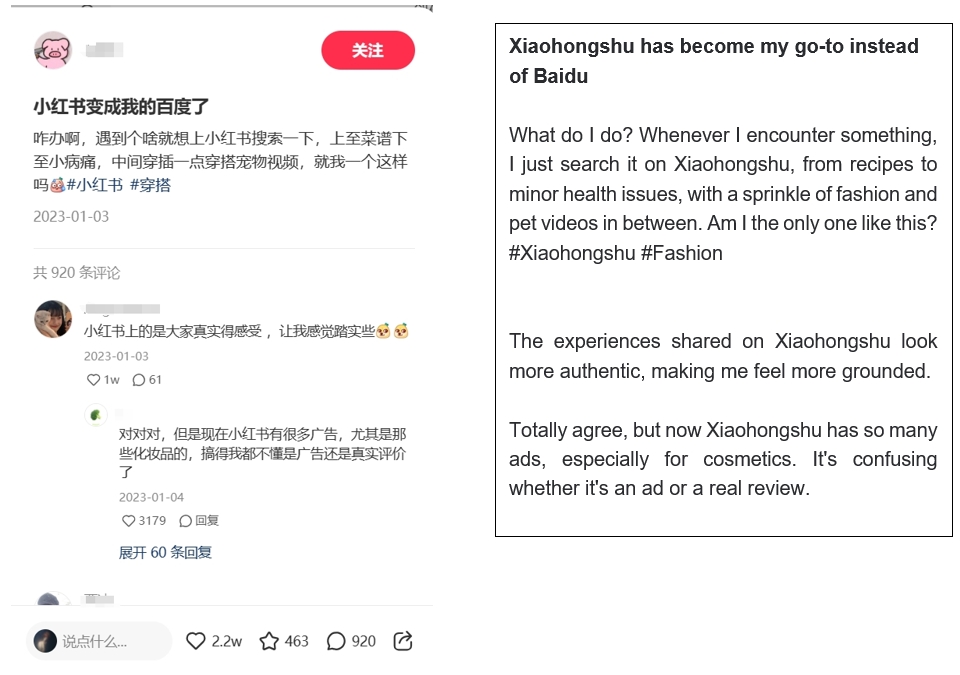
However, it’s essential to consider that Baidu still offers advertising solutions and tools that can be effective for reaching B2B audiences, as B2B companies may still find value in leveraging Baidu’s advertising platform to target specific demographics or industries within the Chinese market.
Is Baidu marketing the right fit for your brand?
- Baidu, holding a 55.8% market share, poses unique challenges for foreign companies due to language complexities, cultural differences, legal considerations, and distinct SEO and SEM methods compared to Google.
- The Baidu Marketing Centre acts as a comprehensive commercial platform, providing valuable insights into market trends, product dynamics, and effective marketing solutions for businesses.
- Baidu offers diverse advertising formats, such as search ads, display ads, mobile ads, and forum ads, enabling advertisers to reach specific target audiences and achieve distinct marketing objectives.
- Despite the rising trend of young users favoring Xiaohongshu for lifestyle-oriented content and niche interests, Baidu remains relevant for B2B advertising, allowing companies to target specific demographics or industries in China.





